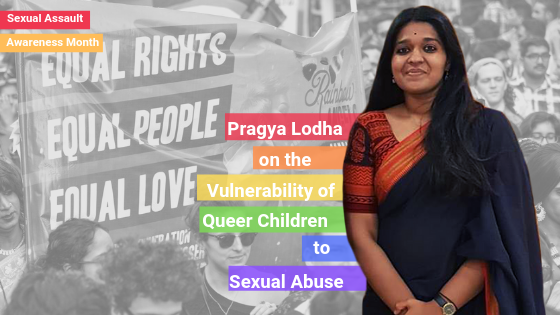Mental health interventions for queer children as survivors of Sexual Abuse

Under sexual violence and sexual crimes, child sexual abuse (CSA) is treated as one of today’s most serious public health problems. The prevalence of CSA among lesbian, gay, bisexual and transgender (LGBT) children are noted to be substantially higher than it is among heterosexual populations.
The prevalence of homophobia in Indian society leads to marginalization of queer individuals as outcasts. They are deferred from equal treatment in all spheres of life. Indian families continue to struggle to accept queer children. This often manifests in feels of abandonment, low self-esteem and self-harm tendencies among the children. In some cultures, it is believed that ‘Corrective rape’, where the queer youth are subjected to rape or forced sexual engagement with the opposite sex, will help ‘transform’ them to becoming straight. There is also a generalized cultural hypersexualization of queer people which commodifies them as objects, readily available for sexual favours. All these factors increase the risk of queer individuals to sexual assault and violence.
When we speaking of sexual violence among queer children, we first need to understand that their sexual and gender identity is independent of their experience of abuse.
Often children develop the belief that their Gender identity and /or orientation are a consequence of the sexual abuse which makes them feel sexually repulsed. However, this notion is not true.
One of my patients, H.R (27 years old) came to me with complaints of feeling depressed, low self-confidence and occasional panic attacks. In his second session itself, he chose to speak about his traumatic experience of child sexual abuse, which continued over 6-7 years, committed by a female member of his extended family. He grew up averse to women but in time, managed to cope with the aversion. However, when he discovered his romantic interest in male – he began questioning whether his feelings were a consequence of the sexual abuse he suffered as a child. In our sessions together, we worked on understanding choices of romantic interest, gender identities and sexual orientations which can be on a spectrum. Through these sessions, he gradually learned to identify himself better and has now started thinking about coming out to his family.
It is a well-documented fact that CSA has a wide-ranging and long-lasting negative impact on victims’ physical health as well as mental health. The layers of stigma are multiple. Here are some of the essentials that mental health professionals need to bear in mind while intervening in such cases:
- Therapists not comfortable with the LGBTQ+ population may refer the clients to Queer-affirmative therapists. And those are unaware must definitely educate themselves about these issues.
- To begin with, affirming the child’s sexual and gender identity is important, so that the child feels accepted for who they are. This fosters better interpersonal relationships and fulfils the child’s need for security.
- Maintaining confidentiality is extremely important as the child may not be ready to disclose their identity to anyone else.
- Therapists must also use their interventions to understand how and when to speak about the queer child’s identity to his / her parents/family with the permission of the child.
- It is very important to convey to the children that it was not their fault and they must not feel guilty for the act of abuse. And also that their sexuality isn’t a reason for their abuse.
Preventing sexual violence and taking care of a child’s mental health requires a joint effort at an interpersonal, societal and governmental level. It is important to let children have their own identities in terms of gender identity or sexual orientation. It is a part of normal development and important for their well-being, self-esteem, and self-confidence. And towards this we must each do our bit to allow our children to believe in and grow in healthier, happier spaces.
References:
- Gibson, L. and Leitenberg, H. 2000. Child sexual abuse prevention programs: Do they decrease the occurrence of child abuse?. Child Abuse and Neglect, 24: 1115–1125.
- Hanson, R. F., Self-Brown, W., Fricker-Elhai, A., Kilpatrick, D. G., Saunders, B. E. and Resnick, H. S. 2006. The relationship between family environment and violence exposure among youth: Findings from the National Survey of Adolescents. Child Maltreatment, 11: 3–15.
- MacLeod, J. and Nelson, G. 2000. Programs for the promotion of family wellness and the prevention of child maltreatment: A meta-analysis. Child Abuse and Neglect, 24: 1127–1150.
- Olafson, E. and Boat, B. 2000. “Long-term management of the sexually abused child: Considerations and challenges”. In Treatment of child Abuse: Common ground for mental health, medical, and legal practitioners, Edited by: Reece, R. M. 14–35. Baltimore, MD & London, England: Johns Hopkins University Press.
ARTICLE WRITTEN BY: Pragya Lodha.She is a Clinical Psychologist and has been an Assistant Professor for Post Graduate Psychology at Maniben Nanavati Women’s College, SNDT University, Mumbai. She is the Programme Director and Head of Operations in Mumbai of The MINDS Foundation. She is the Honorary Assistant Editor of the Indian Journal of Mental Health. She works as a Research Assistant at De Sousa Foundation, Mumbai, and has over 40 National and International publications. Ms. Pragya is the Chief Knowledge Officer of One Future Collective and has been working in the field of mental health, engaging in various on ground and online projects for the last four years. Ms. Lodha is also the Trustee and Core Team Member for Global Society of Digital Psychology, Mumbai.







